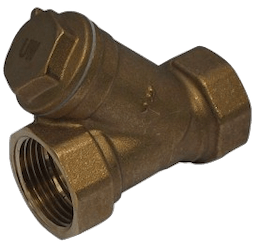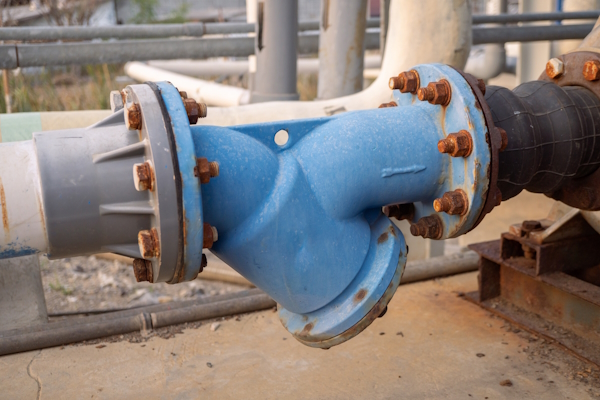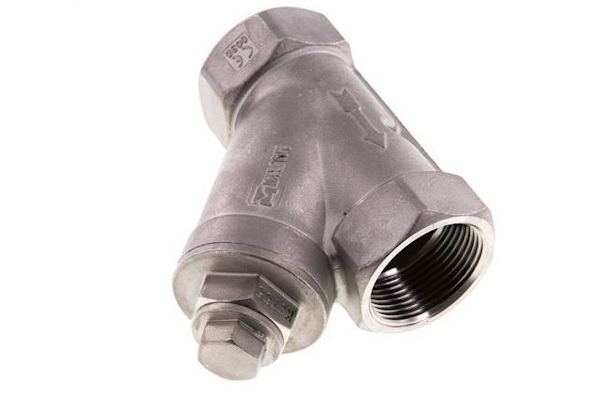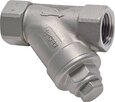How Y Strainers Work

Figure 1: Y Strainer
A Y strainer is a type of mechanical filter used in pipelines to remove unwanted solids from liquids, gases, or steam. It is named for its Y-shaped design, which allows it to be installed in either horizontal or vertical pipelines. This type of filter is essential in numerous fluid control applications to ensure that particles within the fluid do not negatively affect any downstream component.
Table of contents
- Why use a Y strainer?
- Y strainer design
- Sizing the mesh filter
- Material options
- Typical Y strainer applications
- Y strainer selection criteria
- How to install a Y strainer
- FAQs
View our online selection of Y strainers and order today!
Why use a Y strainer?
Any solids entering a system can disrupt and even damage it entirely. Clean fluids can help maximize the reliability and lifespan of any mechanical system. For example, solenoid valves, susceptible to dirt, require clean media. In addition to protecting the performance of solenoid valves, Y strainers also help safeguard other mechanical equipment, including:
- Pumps
- Turbines
- Spray nozzles
- Heat exchangers
- Condensers
- Steam traps
- Meters
A simple Y strainer can protect these components, some of the pipeline's most valuable and expensive parts, from pipe scale, rust, sediment, or other debris.

Figure 2: A Y strainer protects a suction pump from unwanted debris.
Y strainer design
As its name implies, a Y strainer is shaped like a Y. Its mechanical straining process is possible because of a filter element composed of mesh (the most common type), perforated metal, or a wedge wire straining element. Some strainers also include blow-off valves that make cleaning easier in applications with more substantial dirt.
Sizing the mesh filter
It's important to take the time to size the mesh filter correctly. A mesh filter that is too small or too large can negatively affect the system. If the filter is too small, there will be a higher pressure drop from inlet to outlet. Additionally, removing too much debris from the flow can clog the filter and increase the pressure drop. If the filter is too large, the performance and life span of the downstream equipment can be negatively affected.
A mesh filter Y strainer cannot function properly without an appropriately sized mesh filter. Two terms describe the size of the openings in the strainer through which debris passes: micron and mesh size. Though these are two different measurements, they describe the same thing. Learn more in our strainer mesh size article.
Material options
There are various material options for the strainer's housing and seal: brass and stainless steel are commonly used for the housing and PTFE and Teflon are commonly used for the seal.
Stainless steel Y strainers
Stainless steel offers many benefits when it's used to construct Y strainers:
- Corrosion resistance: Highly resistant to rust and corrosion due to chromium content, ideal for moist and chemical environments.
- Durability and strength: Can withstand high pressure and temperature, suitable for demanding industrial applications like oil and gas, chemical processing, and water treatment.
- Hygienic and easy to clean: Non-porous surface prevents bacteria buildup, perfect for food, beverage, and pharmaceutical industries.
- Versatility: Available in different grades, 316 and 304 are most common.
- Aesthetic appeal: Clean, modern look suitable for applications where appearance matters.
- Longevity and cost-effectiveness: Higher initial cost but longer lifespan and lower maintenance lead to lower long-term costs.
- Environmental impact: 100% recyclable, making it an eco-friendly option.
-
Applications:
- Industrial processing: Protects equipment in chemical and oil industries.
- Water treatment: Filters debris in water plants.
- Food and beverage: Ensures product purity.
- Pharmaceutical: Maintains high hygiene standards.

Figure 3: A stainless steel Y strainer
View our online selection of stainless steel Y strainers and order today!
Brass Y strainers
Brass Y strainers offer several advantages when used in various applications:
- Corrosion resistance: Brass is highly resistant to corrosion, making it suitable for plumbing and heating applications where exposure to moisture is common.
- Durability and strength: Brass can withstand moderate pressure and temperature conditions, making it ideal for residential and light commercial use.
- Hygienic and easy to clean: The smooth surface of brass prevents buildup of contaminants, ensuring a clean and hygienic environment, particularly useful in water systems.
- Versatility: Brass Y strainers are versatile and can be used in a variety of applications, including plumbing, heating, and water treatment systems.
- Aesthetic appeal: Brass has a classic, attractive appearance that can complement the design of residential and commercial spaces.
- Longevity and cost-effectiveness: While brass Y strainers may have a higher initial cost compared to some other materials, their durability and low maintenance requirements contribute to lower long-term costs.
- Environmental impact: Brass is recyclable, making it an environmentally friendly option for various applications.
- Applications: Plumbing and Heating: Brass Y strainers are commonly used to protect plumbing and heating systems by filtering out debris.
- Water treatment: Effective in filtering particles in residential and light commercial water treatment systems.
- Residential use: Ideal for use in home plumbing systems due to their durability and corrosion resistance.
- Light commercial use: Suitable for moderate pressure and temperature conditions in commercial settings.
Seal materials
- PTFE: Very common seal material. Handles aggressive environments and low and high temperatures.
- Teflon: Known for its excellent chemical resistance and ability to withstand a wide range of temperatures.
- Learn more in our chemical resistance of materials guide.
Typical Y strainer applications
The material section above mentions several common Y strainer applications. This section offers more. A Y strainer is most valuable in an environment that requires constant protection from debris and contamination. Some of the most common applications are the following.
Steam applications
These strainers are a go-to resource in most steam applications, as their shape is built to handle the high pressure that exists in these environments.
Liquid applications
Liquid applications tend to become infiltrated by sand and gravel, and Y strainers can help keep those particles out to ensure the liquid stays clean. Especially when they work in tandem with other water-handling applications, these strainers can protect important (and expensive) equipment from damage, corrosion, or clogs that could result from such contamination.
Natural gas and air applications
Natural gas and air applications tend to have a low operating pressure, so proper sizing to reduce a pressure drop from inlet to outlet is important.
Y strainer selection criteria
Different kinds of Y strainers on the market are designed to meet various industry needs. Keep the following criteria in mind:
- Port size: Ensure the port size matches the pipeline diameter to maintain optimal flow and system efficiency.
- Filter size: Choose a filter size that effectively captures the debris without significantly restricting flow.
- Housing and filter materials: Select housing and filter materials that are compatible with the fluid and environmental conditions to prevent corrosion and wear.
- The temperature in the environment: Verify that the Y strainer can withstand the operating temperature range of the environment to ensure durability and performance.
- The pressure level in the environment: Ensure the Y strainer is rated for the maximum pressure levels in the system to avoid failure or leakage.
- Preferred installation orientation: Consider the installation orientation (horizontal or vertical) to ensure proper function and ease of access for maintenance.
- The kind of debris in the system: Identify the type of debris present to select an appropriate mesh size and material for the filter.
- Ease of maintenance: Opt for a Y strainer design that allows for easy access and cleaning of the filter to minimize downtime and maintenance efforts.
There is no one-size-fits-all Y strainer that meets every need. That's why it's important to understand the application requirements before selecting a strainer.
How to install a Y strainer
When installing a Y strainer:
-
Preparation:
- Verify compatibility: Ensure the Y strainer's pressure rating is suitable for the application.
- Flow direction: Check the arrow on the strainer that indicates the flow direction. Ensure it will be pointing in the right direction once installed.
- Orientation: Decide whether the strainer will be installed vertically or horizontally. Remember, the filter leg must always point downwards to prevent filtered material from interfering with the main flow.
-
Select installation location:
- Protection: Install the strainer upstream of any equipment it is meant to protect, such as pumps, valves, or meters.
- Accessibility: Ensure there is enough space around the filter leg to open it and clean the inside.
-
Prepare the piping:
- Support: Ensure the pipes that the strainer will connect to are properly supported to prevent any strain on the strainer.
- Clean: Use a pipe deburrer to clean the ends of the pipes to remove any debris or burrs that could interfere with the installation.
-
Install the strainer:
- Connection: Connect the strainer to the piping. Depending on the type of connection (flanged, threaded, or welded), follow the appropriate procedures:
- Flanged: Align the flanges and insert the bolts. Tighten the bolts evenly in a crisscross pattern to ensure a proper seal.
- Threaded: Apply thread sealant or Teflon tape to the pipe threads. Screw the strainer onto the pipe, ensuring it is tight but not over-tightened.
- Welded: If welding is required, ensure proper welding techniques are followed to avoid damaging the strainer.
-
Final checks:
- Alignment: Double-check that the strainer is aligned correctly and the filter leg is pointing downwards.
- Support: Verify that the pipes and the strainer are adequately supported.
- Clearance: Ensure there is sufficient clearance around the filter leg for maintenance and cleaning.
-
System testing:
- Leak test: Slowly pressurize the system and check for any leaks around the strainer connections. If leaks are found, depressurize the system and tighten the connections as needed.
- Flow test: Verify that the flow through the strainer is unobstructed and that the system operates as expected.
FAQs
How should I install my strainer?
Y strainers have an arrow from the inlet to the outlet. It is important to install them in this orientation for proper filtration.
What kind of end connections are available?
Depending on your needs, Y filters can include a variety of end connections, including flanged, threaded and welded. You can also find special flanges, such as ring joints.
What kind of housing material should I choose?
Select the housing material based on the application's environment. To do this, it's necessary to understand the chemical resistances of the materials.
Are Y strainers affordable?
A Y strainer is an affordable alternative to other types of strainers, especially at small sizes.





